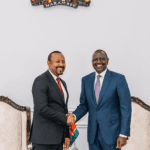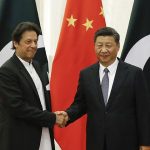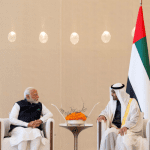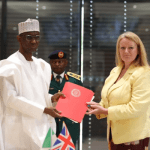The U. S. and India began talks in New Delhi to deepen political and security ties on Thursday September 6, 2018, with officials hoping for an accord on military communications that could lead to increased U.S. arms sales to the South Asian giant.
U.S. Defence Secretary Jim Mattis and Secretary of State Mike Pompeo met with India’s Foreign Minister Sushma Swaraj and Defence Minister Nirmala Sitharaman in a two-plus-two setting.
The world’s two largest democracies have drawn closer in recent years, seeking ways to counter-balance China’s spreading influence across Asia, notably in Pakistan, Southeast Asia and the Indian Ocean.
“My visit is a firm indicator of what we see as India’s place among our most strategic, and I would even call them ‘consequential’ emerging partners,” Mattis told reporters traveling with him to New Delhi.
Before coming to India, Pompeo held talks in Islamabad with Pakistan’s new government and senior most generals.
The presence of U.S. troops in Afghanistan has heightened U.S. sensitivity to the rivalry between nuclear-armed India and Pakistan.
And, Washington and New Delhi share concerns over Pakistan-based anti-Western and anti-Indian Islamist militant groups.
Both the Indian and U.S. governments are keen to sign the Communications Compatibility and Security Agreement (COMCASA), which could open up the way for sales of more sensitive U.S. military equipment to India.
“We have been discussing how we can more openly communicate back and forth because of the sensitivity of some of the technology… we have to know that when we share this with another like-minded nation, that we can keep it secure,” Mattis said.
“I think that we’re pretty much there already, on the American side,” Mattis added.
The U. S. has emerged as India’s second largest arms supplier, closing 15 billion dollars worth of deals in the past decade,
Once the communications accord is in place it could lead to the sale of an armed version of Guardian drones, as Washington has so far only authorized the sale of unarmed, surveillance versions of the aircraft.
Experts believe the signing of the agreement could also reduce the chances of the U. S. imposing sanctions on India for looking to buy Russian S-400 surface-to-air missile systems.
The United States has imposed sweeping sanctions on Russia, under which any country engaged with its defence and intelligence sectors could face secondary U.S. sanctions.
However, a new defense bill proposes giving the U.S. president authority to grant waivers when national security interests are at stake.
The U. S. is also pushing countries to halt oil imports from Iran after U.S President Donald Trump withdrew from a 2015 deal between Iran and six world powers that was intended to stall Tehran’s developing nuclear capabilities.
India is Iran’s top oil buyer after China, and it is seeking a waiver from the United States.
Ahead of the talks in New Delhi, a senior U.S. State Department official said the U.S. was engaged in “very detailed conversations” with India over Washington’s request to completely stop India’s oil imports from Iran.
“We’re asking all of our partners, not just India, to reduce to zero oil imports from Iran and so I’m confident that will be part of our conversation with India,” the official told reporters accompanying Pompeo.
The U. S. and India began talks in New Delhi to deepen political and security ties on Thursday September 6, 2018, with officials hoping for an accord on military communications that could lead to increased U.S. arms sales to the South Asian giant.
U.S. Defence Secretary Jim Mattis and Secretary of State Mike Pompeo met with India’s Foreign Minister Sushma Swaraj and Defence Minister Nirmala Sitharaman in a two-plus-two setting.
The world’s two largest democracies have drawn closer in recent years, seeking ways to counter-balance China’s spreading influence across Asia, notably in Pakistan, Southeast Asia and the Indian Ocean.
“My visit is a firm indicator of what we see as India’s place among our most strategic, and I would even call them ‘consequential’ emerging partners,” Mattis told reporters traveling with him to New Delhi.
Before coming to India, Pompeo held talks in Islamabad with Pakistan’s new government and senior most generals.
The presence of U.S. troops in Afghanistan has heightened U.S. sensitivity to the rivalry between nuclear-armed India and Pakistan.
And, Washington and New Delhi share concerns over Pakistan-based anti-Western and anti-Indian Islamist militant groups.
Both the Indian and U.S. governments are keen to sign the Communications Compatibility and Security Agreement (COMCASA), which could open up the way for sales of more sensitive U.S. military equipment to India.
“We have been discussing how we can more openly communicate back and forth because of the sensitivity of some of the technology… we have to know that when we share this with another like-minded nation, that we can keep it secure,” Mattis said.
“I think that we’re pretty much there already, on the American side,” Mattis added.
The U. S. has emerged as India’s second largest arms supplier, closing 15 billion dollars worth of deals in the past decade,
Once the communications accord is in place it could lead to the sale of an armed version of Guardian drones, as Washington has so far only authorized the sale of unarmed, surveillance versions of the aircraft.
Experts believe the signing of the agreement could also reduce the chances of the U. S. imposing sanctions on India for looking to buy Russian S-400 surface-to-air missile systems.
The United States has imposed sweeping sanctions on Russia, under which any country engaged with its defence and intelligence sectors could face secondary U.S. sanctions.
However, a new defense bill proposes giving the U.S. president authority to grant waivers when national security interests are at stake.
The U. S. is also pushing countries to halt oil imports from Iran after U.S President Donald Trump withdrew from a 2015 deal between Iran and six world powers that was intended to stall Tehran’s developing nuclear capabilities.
India is Iran’s top oil buyer after China, and it is seeking a waiver from the United States.
Ahead of the talks in New Delhi, a senior U.S. State Department official said the U.S. was engaged in “very detailed conversations” with India over Washington’s request to completely stop India’s oil imports from Iran.
“We’re asking all of our partners, not just India, to reduce to zero oil imports from Iran and so I’m confident that will be part of our conversation with India,” the official told reporters accompanying Pompeo.
The U. S. and India began talks in New Delhi to deepen political and security ties on Thursday September 6, 2018, with officials hoping for an accord on military communications that could lead to increased U.S. arms sales to the South Asian giant.
U.S. Defence Secretary Jim Mattis and Secretary of State Mike Pompeo met with India’s Foreign Minister Sushma Swaraj and Defence Minister Nirmala Sitharaman in a two-plus-two setting.
The world’s two largest democracies have drawn closer in recent years, seeking ways to counter-balance China’s spreading influence across Asia, notably in Pakistan, Southeast Asia and the Indian Ocean.
“My visit is a firm indicator of what we see as India’s place among our most strategic, and I would even call them ‘consequential’ emerging partners,” Mattis told reporters traveling with him to New Delhi.
Before coming to India, Pompeo held talks in Islamabad with Pakistan’s new government and senior most generals.
The presence of U.S. troops in Afghanistan has heightened U.S. sensitivity to the rivalry between nuclear-armed India and Pakistan.
And, Washington and New Delhi share concerns over Pakistan-based anti-Western and anti-Indian Islamist militant groups.
Both the Indian and U.S. governments are keen to sign the Communications Compatibility and Security Agreement (COMCASA), which could open up the way for sales of more sensitive U.S. military equipment to India.
“We have been discussing how we can more openly communicate back and forth because of the sensitivity of some of the technology… we have to know that when we share this with another like-minded nation, that we can keep it secure,” Mattis said.
“I think that we’re pretty much there already, on the American side,” Mattis added.
The U. S. has emerged as India’s second largest arms supplier, closing 15 billion dollars worth of deals in the past decade,
Once the communications accord is in place it could lead to the sale of an armed version of Guardian drones, as Washington has so far only authorized the sale of unarmed, surveillance versions of the aircraft.
Experts believe the signing of the agreement could also reduce the chances of the U. S. imposing sanctions on India for looking to buy Russian S-400 surface-to-air missile systems.
The United States has imposed sweeping sanctions on Russia, under which any country engaged with its defence and intelligence sectors could face secondary U.S. sanctions.
However, a new defense bill proposes giving the U.S. president authority to grant waivers when national security interests are at stake.
The U. S. is also pushing countries to halt oil imports from Iran after U.S President Donald Trump withdrew from a 2015 deal between Iran and six world powers that was intended to stall Tehran’s developing nuclear capabilities.
India is Iran’s top oil buyer after China, and it is seeking a waiver from the United States.
Ahead of the talks in New Delhi, a senior U.S. State Department official said the U.S. was engaged in “very detailed conversations” with India over Washington’s request to completely stop India’s oil imports from Iran.
“We’re asking all of our partners, not just India, to reduce to zero oil imports from Iran and so I’m confident that will be part of our conversation with India,” the official told reporters accompanying Pompeo.
The U. S. and India began talks in New Delhi to deepen political and security ties on Thursday September 6, 2018, with officials hoping for an accord on military communications that could lead to increased U.S. arms sales to the South Asian giant.
U.S. Defence Secretary Jim Mattis and Secretary of State Mike Pompeo met with India’s Foreign Minister Sushma Swaraj and Defence Minister Nirmala Sitharaman in a two-plus-two setting.
The world’s two largest democracies have drawn closer in recent years, seeking ways to counter-balance China’s spreading influence across Asia, notably in Pakistan, Southeast Asia and the Indian Ocean.
“My visit is a firm indicator of what we see as India’s place among our most strategic, and I would even call them ‘consequential’ emerging partners,” Mattis told reporters traveling with him to New Delhi.
Before coming to India, Pompeo held talks in Islamabad with Pakistan’s new government and senior most generals.
The presence of U.S. troops in Afghanistan has heightened U.S. sensitivity to the rivalry between nuclear-armed India and Pakistan.
And, Washington and New Delhi share concerns over Pakistan-based anti-Western and anti-Indian Islamist militant groups.
Both the Indian and U.S. governments are keen to sign the Communications Compatibility and Security Agreement (COMCASA), which could open up the way for sales of more sensitive U.S. military equipment to India.
“We have been discussing how we can more openly communicate back and forth because of the sensitivity of some of the technology… we have to know that when we share this with another like-minded nation, that we can keep it secure,” Mattis said.
“I think that we’re pretty much there already, on the American side,” Mattis added.
The U. S. has emerged as India’s second largest arms supplier, closing 15 billion dollars worth of deals in the past decade,
Once the communications accord is in place it could lead to the sale of an armed version of Guardian drones, as Washington has so far only authorized the sale of unarmed, surveillance versions of the aircraft.
Experts believe the signing of the agreement could also reduce the chances of the U. S. imposing sanctions on India for looking to buy Russian S-400 surface-to-air missile systems.
The United States has imposed sweeping sanctions on Russia, under which any country engaged with its defence and intelligence sectors could face secondary U.S. sanctions.
However, a new defense bill proposes giving the U.S. president authority to grant waivers when national security interests are at stake.
The U. S. is also pushing countries to halt oil imports from Iran after U.S President Donald Trump withdrew from a 2015 deal between Iran and six world powers that was intended to stall Tehran’s developing nuclear capabilities.
India is Iran’s top oil buyer after China, and it is seeking a waiver from the United States.
Ahead of the talks in New Delhi, a senior U.S. State Department official said the U.S. was engaged in “very detailed conversations” with India over Washington’s request to completely stop India’s oil imports from Iran.
“We’re asking all of our partners, not just India, to reduce to zero oil imports from Iran and so I’m confident that will be part of our conversation with India,” the official told reporters accompanying Pompeo.
The U. S. and India began talks in New Delhi to deepen political and security ties on Thursday September 6, 2018, with officials hoping for an accord on military communications that could lead to increased U.S. arms sales to the South Asian giant.
U.S. Defence Secretary Jim Mattis and Secretary of State Mike Pompeo met with India’s Foreign Minister Sushma Swaraj and Defence Minister Nirmala Sitharaman in a two-plus-two setting.
The world’s two largest democracies have drawn closer in recent years, seeking ways to counter-balance China’s spreading influence across Asia, notably in Pakistan, Southeast Asia and the Indian Ocean.
“My visit is a firm indicator of what we see as India’s place among our most strategic, and I would even call them ‘consequential’ emerging partners,” Mattis told reporters traveling with him to New Delhi.
Before coming to India, Pompeo held talks in Islamabad with Pakistan’s new government and senior most generals.
The presence of U.S. troops in Afghanistan has heightened U.S. sensitivity to the rivalry between nuclear-armed India and Pakistan.
And, Washington and New Delhi share concerns over Pakistan-based anti-Western and anti-Indian Islamist militant groups.
Both the Indian and U.S. governments are keen to sign the Communications Compatibility and Security Agreement (COMCASA), which could open up the way for sales of more sensitive U.S. military equipment to India.
“We have been discussing how we can more openly communicate back and forth because of the sensitivity of some of the technology… we have to know that when we share this with another like-minded nation, that we can keep it secure,” Mattis said.
“I think that we’re pretty much there already, on the American side,” Mattis added.
The U. S. has emerged as India’s second largest arms supplier, closing 15 billion dollars worth of deals in the past decade,
Once the communications accord is in place it could lead to the sale of an armed version of Guardian drones, as Washington has so far only authorized the sale of unarmed, surveillance versions of the aircraft.
Experts believe the signing of the agreement could also reduce the chances of the U. S. imposing sanctions on India for looking to buy Russian S-400 surface-to-air missile systems.
The United States has imposed sweeping sanctions on Russia, under which any country engaged with its defence and intelligence sectors could face secondary U.S. sanctions.
However, a new defense bill proposes giving the U.S. president authority to grant waivers when national security interests are at stake.
The U. S. is also pushing countries to halt oil imports from Iran after U.S President Donald Trump withdrew from a 2015 deal between Iran and six world powers that was intended to stall Tehran’s developing nuclear capabilities.
India is Iran’s top oil buyer after China, and it is seeking a waiver from the United States.
Ahead of the talks in New Delhi, a senior U.S. State Department official said the U.S. was engaged in “very detailed conversations” with India over Washington’s request to completely stop India’s oil imports from Iran.
“We’re asking all of our partners, not just India, to reduce to zero oil imports from Iran and so I’m confident that will be part of our conversation with India,” the official told reporters accompanying Pompeo.
The U. S. and India began talks in New Delhi to deepen political and security ties on Thursday September 6, 2018, with officials hoping for an accord on military communications that could lead to increased U.S. arms sales to the South Asian giant.
U.S. Defence Secretary Jim Mattis and Secretary of State Mike Pompeo met with India’s Foreign Minister Sushma Swaraj and Defence Minister Nirmala Sitharaman in a two-plus-two setting.
The world’s two largest democracies have drawn closer in recent years, seeking ways to counter-balance China’s spreading influence across Asia, notably in Pakistan, Southeast Asia and the Indian Ocean.
“My visit is a firm indicator of what we see as India’s place among our most strategic, and I would even call them ‘consequential’ emerging partners,” Mattis told reporters traveling with him to New Delhi.
Before coming to India, Pompeo held talks in Islamabad with Pakistan’s new government and senior most generals.
The presence of U.S. troops in Afghanistan has heightened U.S. sensitivity to the rivalry between nuclear-armed India and Pakistan.
And, Washington and New Delhi share concerns over Pakistan-based anti-Western and anti-Indian Islamist militant groups.
Both the Indian and U.S. governments are keen to sign the Communications Compatibility and Security Agreement (COMCASA), which could open up the way for sales of more sensitive U.S. military equipment to India.
“We have been discussing how we can more openly communicate back and forth because of the sensitivity of some of the technology… we have to know that when we share this with another like-minded nation, that we can keep it secure,” Mattis said.
“I think that we’re pretty much there already, on the American side,” Mattis added.
The U. S. has emerged as India’s second largest arms supplier, closing 15 billion dollars worth of deals in the past decade,
Once the communications accord is in place it could lead to the sale of an armed version of Guardian drones, as Washington has so far only authorized the sale of unarmed, surveillance versions of the aircraft.
Experts believe the signing of the agreement could also reduce the chances of the U. S. imposing sanctions on India for looking to buy Russian S-400 surface-to-air missile systems.
The United States has imposed sweeping sanctions on Russia, under which any country engaged with its defence and intelligence sectors could face secondary U.S. sanctions.
However, a new defense bill proposes giving the U.S. president authority to grant waivers when national security interests are at stake.
The U. S. is also pushing countries to halt oil imports from Iran after U.S President Donald Trump withdrew from a 2015 deal between Iran and six world powers that was intended to stall Tehran’s developing nuclear capabilities.
India is Iran’s top oil buyer after China, and it is seeking a waiver from the United States.
Ahead of the talks in New Delhi, a senior U.S. State Department official said the U.S. was engaged in “very detailed conversations” with India over Washington’s request to completely stop India’s oil imports from Iran.
“We’re asking all of our partners, not just India, to reduce to zero oil imports from Iran and so I’m confident that will be part of our conversation with India,” the official told reporters accompanying Pompeo.
The U. S. and India began talks in New Delhi to deepen political and security ties on Thursday September 6, 2018, with officials hoping for an accord on military communications that could lead to increased U.S. arms sales to the South Asian giant.
U.S. Defence Secretary Jim Mattis and Secretary of State Mike Pompeo met with India’s Foreign Minister Sushma Swaraj and Defence Minister Nirmala Sitharaman in a two-plus-two setting.
The world’s two largest democracies have drawn closer in recent years, seeking ways to counter-balance China’s spreading influence across Asia, notably in Pakistan, Southeast Asia and the Indian Ocean.
“My visit is a firm indicator of what we see as India’s place among our most strategic, and I would even call them ‘consequential’ emerging partners,” Mattis told reporters traveling with him to New Delhi.
Before coming to India, Pompeo held talks in Islamabad with Pakistan’s new government and senior most generals.
The presence of U.S. troops in Afghanistan has heightened U.S. sensitivity to the rivalry between nuclear-armed India and Pakistan.
And, Washington and New Delhi share concerns over Pakistan-based anti-Western and anti-Indian Islamist militant groups.
Both the Indian and U.S. governments are keen to sign the Communications Compatibility and Security Agreement (COMCASA), which could open up the way for sales of more sensitive U.S. military equipment to India.
“We have been discussing how we can more openly communicate back and forth because of the sensitivity of some of the technology… we have to know that when we share this with another like-minded nation, that we can keep it secure,” Mattis said.
“I think that we’re pretty much there already, on the American side,” Mattis added.
The U. S. has emerged as India’s second largest arms supplier, closing 15 billion dollars worth of deals in the past decade,
Once the communications accord is in place it could lead to the sale of an armed version of Guardian drones, as Washington has so far only authorized the sale of unarmed, surveillance versions of the aircraft.
Experts believe the signing of the agreement could also reduce the chances of the U. S. imposing sanctions on India for looking to buy Russian S-400 surface-to-air missile systems.
The United States has imposed sweeping sanctions on Russia, under which any country engaged with its defence and intelligence sectors could face secondary U.S. sanctions.
However, a new defense bill proposes giving the U.S. president authority to grant waivers when national security interests are at stake.
The U. S. is also pushing countries to halt oil imports from Iran after U.S President Donald Trump withdrew from a 2015 deal between Iran and six world powers that was intended to stall Tehran’s developing nuclear capabilities.
India is Iran’s top oil buyer after China, and it is seeking a waiver from the United States.
Ahead of the talks in New Delhi, a senior U.S. State Department official said the U.S. was engaged in “very detailed conversations” with India over Washington’s request to completely stop India’s oil imports from Iran.
“We’re asking all of our partners, not just India, to reduce to zero oil imports from Iran and so I’m confident that will be part of our conversation with India,” the official told reporters accompanying Pompeo.
The U. S. and India began talks in New Delhi to deepen political and security ties on Thursday September 6, 2018, with officials hoping for an accord on military communications that could lead to increased U.S. arms sales to the South Asian giant.
U.S. Defence Secretary Jim Mattis and Secretary of State Mike Pompeo met with India’s Foreign Minister Sushma Swaraj and Defence Minister Nirmala Sitharaman in a two-plus-two setting.
The world’s two largest democracies have drawn closer in recent years, seeking ways to counter-balance China’s spreading influence across Asia, notably in Pakistan, Southeast Asia and the Indian Ocean.
“My visit is a firm indicator of what we see as India’s place among our most strategic, and I would even call them ‘consequential’ emerging partners,” Mattis told reporters traveling with him to New Delhi.
Before coming to India, Pompeo held talks in Islamabad with Pakistan’s new government and senior most generals.
The presence of U.S. troops in Afghanistan has heightened U.S. sensitivity to the rivalry between nuclear-armed India and Pakistan.
And, Washington and New Delhi share concerns over Pakistan-based anti-Western and anti-Indian Islamist militant groups.
Both the Indian and U.S. governments are keen to sign the Communications Compatibility and Security Agreement (COMCASA), which could open up the way for sales of more sensitive U.S. military equipment to India.
“We have been discussing how we can more openly communicate back and forth because of the sensitivity of some of the technology… we have to know that when we share this with another like-minded nation, that we can keep it secure,” Mattis said.
“I think that we’re pretty much there already, on the American side,” Mattis added.
The U. S. has emerged as India’s second largest arms supplier, closing 15 billion dollars worth of deals in the past decade,
Once the communications accord is in place it could lead to the sale of an armed version of Guardian drones, as Washington has so far only authorized the sale of unarmed, surveillance versions of the aircraft.
Experts believe the signing of the agreement could also reduce the chances of the U. S. imposing sanctions on India for looking to buy Russian S-400 surface-to-air missile systems.
The United States has imposed sweeping sanctions on Russia, under which any country engaged with its defence and intelligence sectors could face secondary U.S. sanctions.
However, a new defense bill proposes giving the U.S. president authority to grant waivers when national security interests are at stake.
The U. S. is also pushing countries to halt oil imports from Iran after U.S President Donald Trump withdrew from a 2015 deal between Iran and six world powers that was intended to stall Tehran’s developing nuclear capabilities.
India is Iran’s top oil buyer after China, and it is seeking a waiver from the United States.
Ahead of the talks in New Delhi, a senior U.S. State Department official said the U.S. was engaged in “very detailed conversations” with India over Washington’s request to completely stop India’s oil imports from Iran.
“We’re asking all of our partners, not just India, to reduce to zero oil imports from Iran and so I’m confident that will be part of our conversation with India,” the official told reporters accompanying Pompeo.













